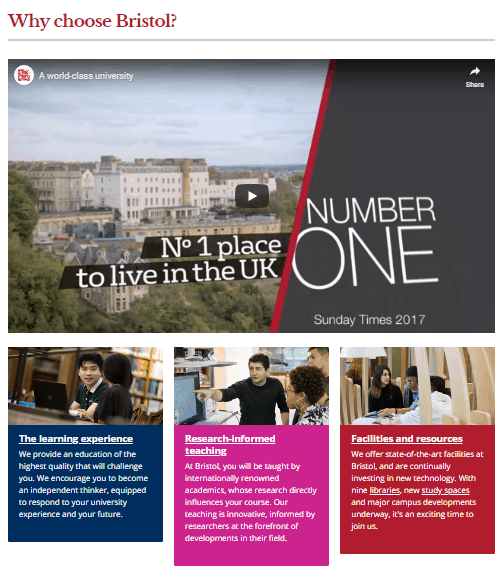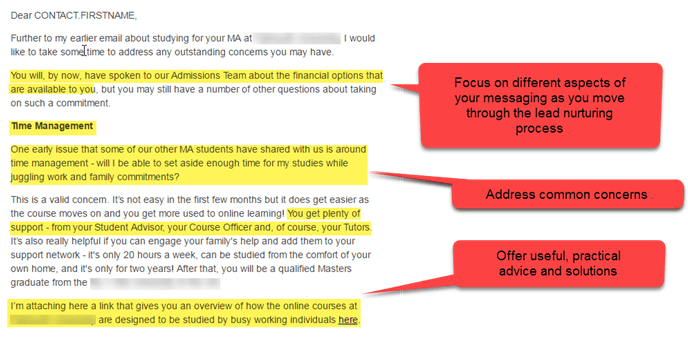
What would you say if you were asked to describe your school in one or two sentences? How about if you were asked to list your main selling points? Or if you were tasked with showing evidence of the results you achieve?
Key message development will help you find the answers to these questions. An essential component of marketing strategies for organizations in all kinds of industries, this exercise is a tried and trusted way of getting to the heart of what makes you unique, what you have to offer, and why your audience should be interested in it.
For schools, key messages can help focus and align what you communicate during your student recruitment campaigns. Read on to find out how.
What are Key Student Recruitment Messages?
In essence, key messages are short, two or three line statements which outline the main selling points of your school or courses. They are not taglines or slogans, nor are they phrases which should necessarily be repeated word for word in your student recruitment content.
Instead, they can be used as a touchstone to guide your team in everything from web content creation, to print marketing, to face-to-face communications. Key messages ensure that everyone is on the same page about what aspects of your school and courses they should be emphasizing, and keeps your overall strategy consistent, coherent, and targeted towards clear goals.
A good rule of thumb is to create key messages as you create your student personas, developing a specific set of messaging for each one. You can then consider your personas’ principle goals, motivations and pain points and ensure your key messages have an answer for all of them.
Example: An excerpt from the personas and key messages of a leading European university. Note how the well the messages align with the persona’s motivations.

The format and structure of key messages is something that varies widely between organizations depending on their practices and preferences, and you will likely find a number of different templates and frameworks on the web which may or may not work for your school’s specific needs. At HEM, we advocate using a simple, flexible structure of 7-10 messages, which will generally include the following components:
- A central key message
- Primary supporting messages
- Secondary supporting messages
- Proof points
Below are some details on how to go about developing each of these, as well as some recruitment messages samples from a range of different institutions.
Start with a Central Overall Key Message That Encapsulates Your School
The very first message you get down on paper should be a central overall message that succinctly describes the essence of what you offer and its benefits, and will lay the foundation for the supporting messages which follow it. For most schools, this will be a short description of your institution, like this example for an ESL school:

Schools working on a larger scale or doing more targeted student recruitment for specific courses may create a central key message for individual programs:

Regardless of your approach, the aim will be the same: to detail your unique value proposition in an easy-to-understand way that aligns with what your targeted personas want. The language should be clear, and free of jargon or sloganeering. Remember, the point of this exercise is to develop a document you can use internally to give your marketing efforts more focus, so the message doesn’t need to be a clever catchphrase or tagline; just a simple, true reflection of what you have to offer.
While this may seem straightforward, it can be more difficult than you think. Many institutions will have trouble pinning down exactly what their central recruitment message should be, or finding one that truly differentiates them from their competitors.
To counter this, it can be a good tip to consult your key stakeholders, including both your admissions team and academic staff, to gauge their opinions and ensure everyone is in agreement about what your school should represent.
A useful exercise might be to ask each member of your team to describe your school or the course in question in 20 words or less, and write the answer on a piece of paper. You can then discuss the answers in a group and see which one is the closest to resonating with everyone.
Additionally, many schools will find they are already communicating this idea in their marketing materials, even if they have not been doing it consciously. Look through your website, social media content, student recruitment emails, and ads, and you might find a simple phrase or statement which is close to conveying what you want.
Example: The first paragraph of this page on the University of British Columbia’s website reads almost like a central key message.

Developing Your School’s Primary Supporting Key Messages
Of course, it’s not possible to capture everything that’s great about your school in just a few words. While a central message helps to establish your unique value proposition, it should always be supported by additional key messages which expand upon specific aspects of your programs and courses and reinforce their advantages in more detail.
You can think of your primary supporting messages as the key ingredients that make your school what it is. Most likely, these will include things like the quality of your instructors, your facilities, and the range of programs you offer. You might also wish to communicate something unique about your learning or instructional approach, such as an emphasis on practical training. Here’s an example from a private boarding school that made technology a central part of its philosophy:

Again, it’s important when doing this to refer back to your student personas, and use their goals and common concerns to guide your messaging strategy. This key message, for instance, is from a school whose target audience were often concerned about the cost of financing their studies:

As you can see, the message provides a solution to a key barrier to entry. By keeping this in mind when creating content and mentioning it where relevant, the school can then ease the path to enrollment for potential applicants.
These messages will flesh out your central key message to paint a clearer picture of your school’s main selling points, and give your team a variety of advantages to stress and different angles to take in both your promotional content and your direct contact with prospective students.
Use Secondary Supporting Student Recruitment Messages to Address Smaller Details
Of course, for many schools, particularly those in competitive sectors, prospective students are often won and lost based on small details. Your target audience may have some specific motivations and concerns that don’t relate directly to the overall quality of your programs and courses or your other main selling points, but are nonetheless very important to them.
For instance, many university students place huge value on the social aspect of college life, and the extracurricular and social calendar you offer may need to be worked into your key messaging:

Supplementary services such as accommodation and career support are other good examples of these kinds of points. The parents of private boarding school students, for example, are likely to be concerned about what kind of supervision you provide to ensure their children are safe and happy, and this may need to be worked into your messaging:

Things like this will likely not be the main reason a prospective student chooses to enroll at your school, but could be a valuable differentiator when faced with a choice between two or more competing options with little to choose between them.
Adding Proof Points to Your Key Recruitment Messages
Another way to differentiate your school from your competitors is to include what marketing experts call ‘proof points’ within your recruitment messages. These are tangible pieces of evidence which back up the statements you are making about your school’s main USPs, and could include things like statistics, lists of companies graduates have gone on to work for, or college rankings.
A proof point adds weight to your key messaging statements, helping ensure your marketing materials come across as trustworthy, rather than a series of unsubstantiated promises. Proof points don’t necessarily have to be separate items, and could be worked into another key message, like this:

Including the percentage of graduates who find careers within their fields in this point helps to reinforce its validity with indisputable evidence of the school’s success. A longer, more substantial proof point could also be a key message in itself:

With social proof becoming increasingly important in modern digital marketing, incorporating proof points into your key messaging approach can be a great way to make sure it is deeply ingrained into your overall student recruitment strategy.
Putting Key Messaging into Action in Your Student Recruitment Campaigns
Once you have created key messages, you should make every effort to ensure that they are incorporated into your digital marketing efforts. As mentioned before, they should not necessarily be repeated word-for-word in your content, but should instead be used as a guide which help your recruitment team ensure it is reiterating your school’s main USPs consistently.
The influence of a good key messaging strategy can be seen across a range of channels. For a start, your program pages and other web pages can become more focused and targeted. Many schools will even have dedicated web pages of ‘reasons to choose’ their institution which in themselves are similar to a key messages list.
Example: The Why Choose Bristol? page on the University of Bristol’s website reads like a rundown of their key messages. Each of their USPs is given its own section, and also links to a unique page which goes into more detail.

Key messaging can also be crucial when creating paid advertising campaigns. Because paid search and social media ads will often give you limited character counts to work with, it can be difficult to create copy that hits all the points it needs to. Having your ad creators use the key messages as a reference point when writing them can help you make sure that not a single word is wasted.
Example: This Facebook ad from Inlingua Victoria is a good example of a school who knows exactly what the main USP of its course is – the opportunity to teach anywhere in the world – and communicates it clearly within limited copy.

Key messaging can also inform blog and social media content creation. For instance, if one of your primary key messages relates to career outcomes for graduates, blogs detailing different career options might be a good fit for your school. Similarly, schools whose key messages include information about their social or extracurricular activities might feature posts which touch on these areas more than institutions for which this is less of a priority.
Finally, key messaging can be a godsend for your admissions team when following up on inquires with prospective students. By having a list of your school’s principal strengths to hand, your advisors will be more ready to answer common questions and queries, and be able to foster an assured impression of your school. You can even create email templates covering each of your key message points which can be sent to students as they progress through the enrollment journey.
Example: An email developed for an MA program with key messages and common persona motivations and concerns in mind.

While key messaging can have a million uses for schools, it’s worth bearing in mind the need to be flexible and proactive in this area. Your school should review its campaigns to ensure that your marketing efforts don’t become too repetitive or generic, and that its messaging is updated to reflect the evolving needs of its student base. By doing this simple task well, you will lay a foundation that can be built upon in almost every area of your student recruitment strategy.







